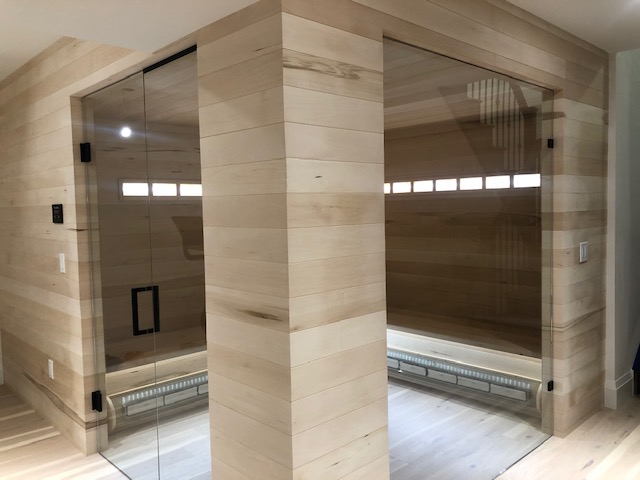Whether to buy an Infrared sauna vs traditional sauna is a critical question when deciding where to invest your money in a personal sauna. Or even a commercial sauna for that matter.
The best way to assess this question is to first assess your personal position and habits. ie. Do you want to use the sauna every day? Every other day? Once a week? Do you like the heat to be so hot you almost can’t stand it? Like a challenge? Or do you like a comfortable warm environment that you can relax in for 30-40 minutes? Are you using it after a long workout? Or are you trying to heal from a chronic illness and a health care practitioner advised you to try sweating more?
These are some of the questions and positions that lead sauna customers to examine whether to chose an infrared sauna vs traditional sauna.
Traditional Saunas are very hot
The joy, and the horror, of traditional saunas is that they operate best above 60 degrees Celcius. That’s 140 Fahrenheit, and they can typically get as high as 200F. That’s almost boiling point. And since human’s are largely made of water that means you sort of start to boil too. That’s why those saunas can feel so uncomfortably hot. For some people that heat is what they are seeking and the hotter it gets the better. For these people, the question of infrared sauna vs traditional sauna has an easy answer: The hotter the better!
One downside of this heat requirement is that traditional saunas also take about an hour or more to get hot enough for you to use them. They also require a lot more electricity to get that hot. Usually about 6,000 – 8,000 watts for a typical sauna room size of 30-50 square feet. These saunas must be carefully constructed in the home or commercial space with sufficient insulation behind the walls to retain the heat inside the sauna, and to ensure the structural material on the other side of the wall isn’t overheating the rest of your building. They also require good ventilation so the heat can dissipate.
On top of all that, most people who like the very hot saunas also like to generate steam inside. That’s a big difference between infrared sauna vs traditional sauna. The traditional saunas have such a red-hot heating coil that they can get hot enough to transfer that red-hot energy into volcanic rocks on top of the sauna heater. When those rocks get hot you can splash water on them that instantly turns to steam and fills the room with superheated water vapor. When that vapor lands on your skin it converts back to liquid, releasing an energy that stings your skin. This is a little painful, and hard to breathe, but it is actually what some people seek in a sauna. However, to do this you need plumbing inside your sauna to bring water to the room. You also need a floor drain to make sure all that steam is safely drained after it cools and converts back into liquid water.
Infrared saunas are more gentle and comfortably warm
If you’re wondering why so many more people are buying an infrared sauna, these days, it’s probably because they aren’t nearly as hot. A good medical grade infrared sauna, ie. one that uses solid plate ceramic elements instead of tubes or plastic style carbon fiber floor heaters, will function correctly from 25-45C or 78-114F. This means you only have to turn it on for about 15 minutes before it’s ready to go inside. “Ready” doesn’t mean it’s at its peak temperature. It just means it’s warm enough for you to sit inside without any clothes on. From there you feel the super relaxing infrared heat and you can let it slowly rise while you adapt to it. Once it reaches 40C or 104F, most people are sweating profusely and almost ready to come out.
This usually takes about 30 minutes. That’s another reason why the infrared sauna vs traditional sauna is preferred by so many people these days. A traditional sauna is so hot you have to keep coming out to cool down, and then go back inside. The entire process can take up to an hour. And when you add the one hour plus heat up time, you are looking at a two hour time commitment to have a sauna.
An infrared sauna vs traditional sauna is the difference of a 30-40 minute time commitment, vs two hours.
Infrared Saunas are Easy to Install
When it comes to installation the infrared sauna vs traditional sauna wins hands down every time. Even a large 6×8’ (almost 50 square feet) infrared sauna can be installed in any room of your home in under an hour. They are designed to come apart into the wall components so they can easily be carried into any home of office or commercial space, and reassembled in minutes. Many of them can be plugged into a regular household electrical outlet. Even the larger 220 volt units only require 4,000 watts vs the 8,000 watts for a traditional sauna of the same size. This also means the infrared sauna costs a lot less in electricity to run it. Usually infrared sauna vs traditional sauna represents an operating costs of 25 cents per session vs $2.00 per session. If you are using it every day this means $7/ month vs $60/month or $80/year vs $700 year. Just for a sauna! Some infrared saunas even operate on only 1,100 watts so people who live in solar powered homes or mobile homes can install them with confidence.
Convenience
The last big point in the advantage of infrared sauna vs traditional sauna, is that you can put one easily in any room of your home. The traditional saunas usually need to be built by a team of carpenters, electrician and plumber and are normally placed in a basement due to the floor drain. But an infrared sauna uses no water so it doesn’t need a drain. That means you can put one in an upstairs bedroom, a spare room, even a hallway or a closet. Usually, one person can carry it into the home wall by wall in a few minutes and then set it up in a few minutes. Infrared saunas are normally portable so they can later be disassembled and moved to another room, or even taken with you when you move to a new home.
That makes infrared sauna vs traditional sauna hands down the ideal choice for most people searching for which way to go.


